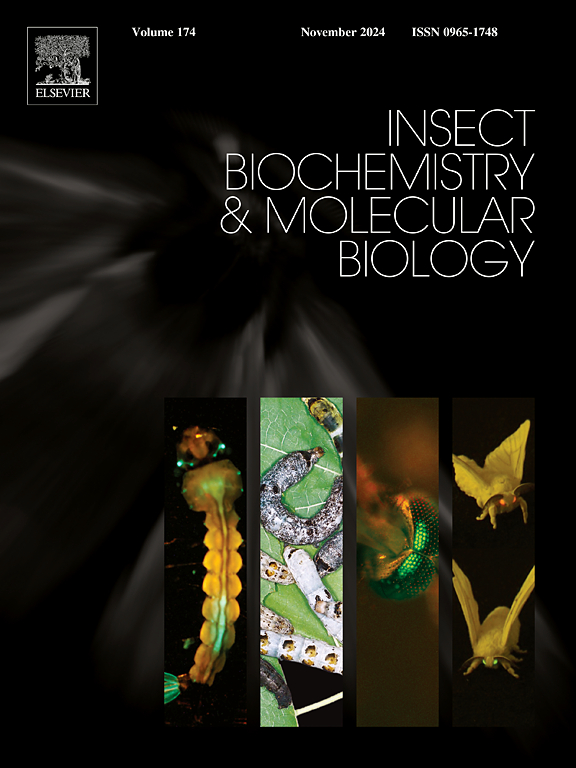Identification and functional analysis of sex-determining genes in the spongy moth, Lymantria dispar (lepidoptera: Erebidae)
IF 3.7
2区 农林科学
Q2 BIOCHEMISTRY & MOLECULAR BIOLOGY
引用次数: 0
Abstract
The spongy moth (Lymantria dispar) employs a female heterogametic sex-determination system, where the female sex-determining factor (F factor) is located on the W chromosome, and the male sex-determining factor (M factor) is located on the Z chromosome. The sex-determining capabilities of the F factor and M factor vary among subspecies. Consequently, L. dispar serves as an excellent model for studying the mechanisms underlying the evolution and diversity of sex-determining genes. However, the genes encoding the F and M factors, as well as the molecular functions of their translation products, remain unidentified.
In this study, we identified a L. dispar Masculinizer ortholog (LdMasc) and found that this gene is highly expressed in male embryos during the sex-determination stage. When LdMasc expression was silenced using embryonic RNA interference (RNAi), the expression pattern of L. dispar doublesex (Lddsx), the master regulatory gene for sex differentiation, shifted from the male-specific form to the female-specific form in male embryos. To identify potential F factors, we screened for genes that were exclusively expressed in females across multiple tissues and located only within the female genome. This screening yielded four unigenes with sequences displaying high homology to each other. These unigenes formed a tandem repeat, comprising approximately 100 copies within a 200 kbp region of the W chromosome-derived contig. We designated these unigenes as Fet-W (female-specifically expressed transcript from the W chromosome). RT-PCR analysis revealed that Fet-W was expressed in a female-specific manner during the sex-determination stage. Suppression of Fet-W expression by embryonic RNAi led to an increase in LdMasc expression in females and a corresponding shift in dsx expression patterns from the female-specific to the male-specific form. These findings strongly suggest that the F factor in L. dispar is Fet-W, whereas the M factor is LdMasc.

海绵蛾 Lymantria dispar(鳞翅目:Erebidae)性别决定基因的鉴定和功能分析。
海绵蛾(Lymantria dispar)采用雌雄异配性别决定系统,其中雌性性别决定因子(F因子)位于W染色体上,雄性性别决定因子(M因子)位于Z染色体上。F 因子和 M 因子的性别决定能力因亚种而异。因此,L. dispar 是研究性别决定基因进化和多样性机制的极佳模型。然而,编码 F 因子和 M 因子的基因及其翻译产物的分子功能仍未确定。在这项研究中,我们确定了一种 L. dispar Masculinizer 同源物(LdMasc),并发现该基因在性别决定阶段的雄性胚胎中高度表达。当使用胚胎 RNA 干扰(RNAi)抑制 LdMasc 的表达时,性别分化的主调控基因 L. dispar doublesex(Lddsx)在雄性胚胎中的表达模式从雄性特异性形式转变为雌性特异性形式。为了确定潜在的 F 因子,我们筛选了在多个组织中只在雌性体内表达且只位于雌性基因组内的基因。筛选结果显示,有四个基因的序列具有高度同源性。这些单基因形成了一个串联重复,在源自 W 染色体的等位基因的 200 kbp 区域内约有 100 个拷贝。我们将这些单基因命名为 Fet-W(来自 W 染色体的雌性特异性表达转录本)。RT-PCR分析表明,Fet-W在性别决定阶段以雌性特异的方式表达。通过胚胎 RNAi 抑制 Fet-W 的表达会导致雌性 LdMasc 的表达增加,dsx 的表达模式也会相应地从雌性特异性形式转变为雄性特异性形式。这些发现有力地表明,L. dispar的F因子是Fet-W,而M因子是LdMasc。
本文章由计算机程序翻译,如有差异,请以英文原文为准。
求助全文
约1分钟内获得全文
求助全文
来源期刊
CiteScore
7.40
自引率
5.30%
发文量
105
审稿时长
40 days
期刊介绍:
This international journal publishes original contributions and mini-reviews in the fields of insect biochemistry and insect molecular biology. Main areas of interest are neurochemistry, hormone and pheromone biochemistry, enzymes and metabolism, hormone action and gene regulation, gene characterization and structure, pharmacology, immunology and cell and tissue culture. Papers on the biochemistry and molecular biology of other groups of arthropods are published if of general interest to the readership. Technique papers will be considered for publication if they significantly advance the field of insect biochemistry and molecular biology in the opinion of the Editors and Editorial Board.

 求助内容:
求助内容: 应助结果提醒方式:
应助结果提醒方式:


